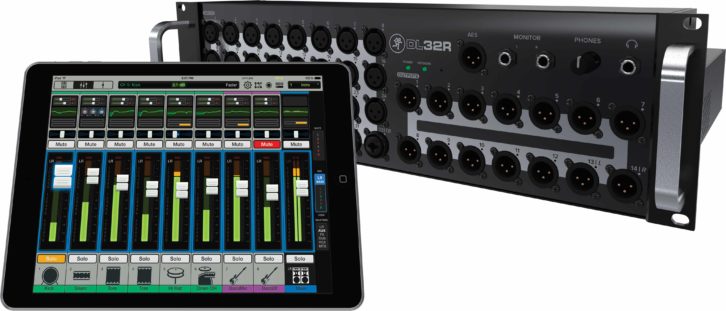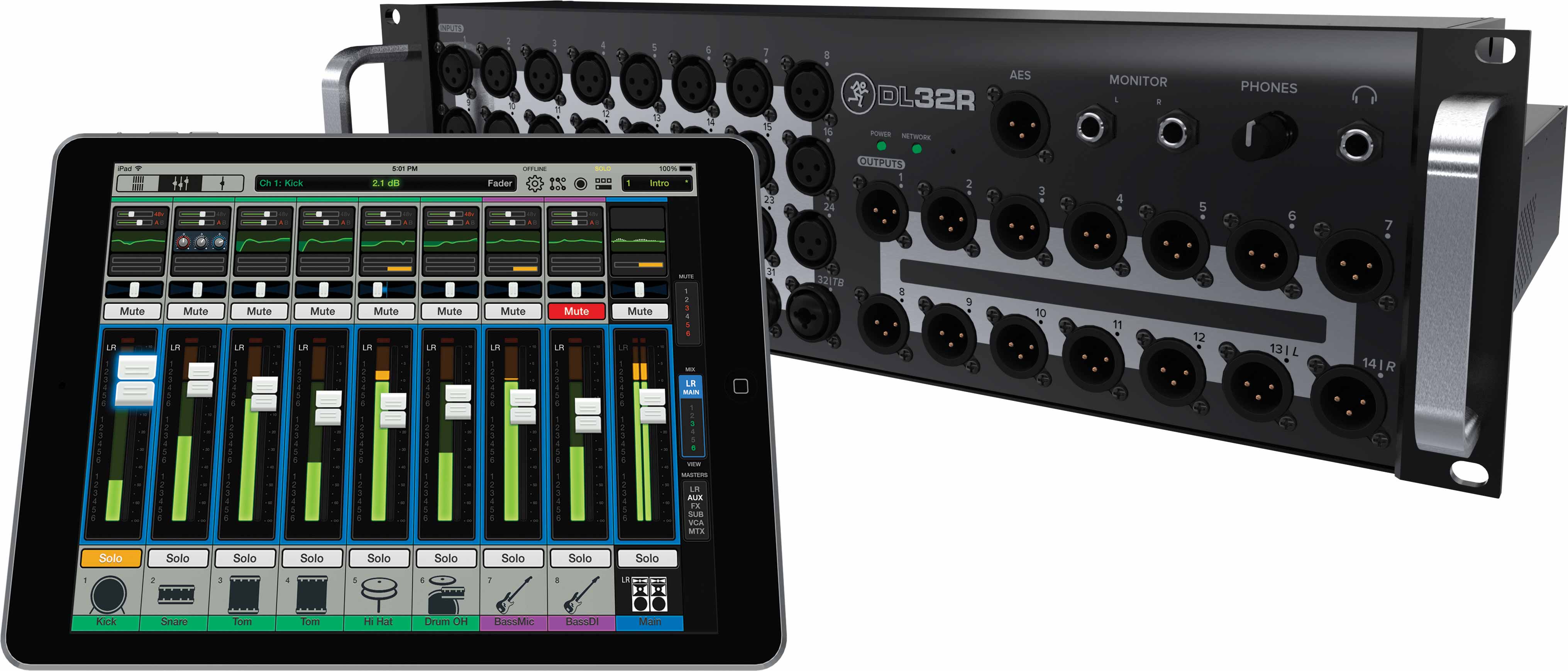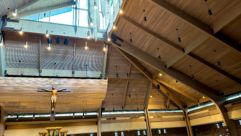

The conversation was about 20 years ago—a discussion among pro audio colleagues in which the claim was made that we would soon “mix on glass control surfaces”. A few snickered at this farfetched flight of fancy, but some of us stared wistfully off into space, carried away by daydreams of the utopia to come.
Fast-forward to the second decade of the 21st century, and indeed, we can now control every parameter of a mixer by touching the glass surface of an iPad or other tablet device. In fact, this capacity has existed for a few years now. But until recently, the tablet only gave us remote control of a traditional mixer with all the usual knobs, buttons, and faders. A few years ago, Mackie took one small step toward our glass panel future with the DL806 and DL1608—mixers physically constructed in the traditional form factor, but with a detachable iPad replacing nearly all the knobs, buttons, and faders. Mackie has now taken an additional giant leap for mankind—a mixer controlled exclusively by an iPad, with its only physical component being a rack-mounted I/O and mix core unit. Separating the mix core from the control surface is nothing new, but to the best of my knowledge, this is the first mixer controlled exclusively by a “glass control surface,,” the Jetson-esque suggestion put forth by my colleague so long ago. I was very eager to get my hands on the system.
The Mackie DL32R physical component is three rack units tall, and the left half of its front panel presents 32 XLR inputs, 24 of which are traditional XLR connectors, and eight of which are of the variety that also accept ¼-in plugs. Fourteen XLR outputs encompass the lower right quarter of the panel, and above them are found an AES XLR output, two ¼-in monitor output jacks, one ¼-in headphone output jack with a corresponding level knob, and LEDs to indicate network status and power. Behind the front panel, the unit’s enclosure sharply slopes down to two rack units in height, creating a de facto “shelf” for a WiFi router and/or USB hard drive for recording. Mackie even included “bridges” through which to run straps for securing such devices. The sparse rear panel features an IEC AC power inlet, power switch, two cooling fans, an expansion slot, and USB ports—one each of A and B varieties. As of this writing, a Dante interface card for the slot is slated to ship soon, and I’d expect other formats before long. The USB A port enables 24-track recording to an external hard drive (Mackie reports that a future firmware update will enable 32×32). The USB B port makes the DL32R an audio class 2.0-compliant device with 32 channels each of recording and playback.
The physical I/O and mix core rack unit will likely be installed and largely forgotten by most users, provided that I/O connections are relatively static. Users control the system with an iPad using Mackie’s Master Fader app, which displays three primary views: Overview, Mixer View, and Channel View. Overview shows metering and faders for all inputs and outputs, Mixer View is a more detailed look at nine channels at a time, including the master. Channel view shows a single channel in complete detail. System-level views allow configuration of signal routing, network, and security settings, among others. Every parameter of the DL32R is under the exclusive control of the app— there is literally no other way to make changes— and this raises a small quibble. Despite all our advances, anomalies still happen, caused by hardware and human alike. If a massive runaway feedback loop starts while our WiFi router has lost power for some reason, we can’t mute inputs or outputs. Even if the rack unit’s location requires a sprint across the room, a button that globally mutes all outputs would be a nice addition, particularly for engineers who cannot mute their amps with an iPad app.
The Master Fader app is complex, and complex apps on physically small devices can force a lot of menu-diving; Mackie makes it painless by keeping it graphical in nature. I really like the quick access panel button, which immediately enables the clearing of solos, muting of reverb and delay returns, tempo-tapping for delays, talkback activation, and delay speaker time alignment. Yes—I said delay speaker time alignment. It’s very intuitive for people accustomed to traditional consoles: swipe or touch something, and a popover appears with more detail. Touch a fader and it “grows and glows” (in the Mackie vernacular) to indicate that it has become the focus. Color-coding clarifies the display and greatly reduces the chance of adjusting the wrong thing. A library of icons also improves channel identification and I love that I can identify channels with photos taken by the iPad camera: A photo of the bassist singing into a microphone becomes their vocal channel image; a wider photo of them playing bass becomes their bass channel image. These images populate across all other WiFi-connected iOS devices, so everyone with access to the mixer sees the same thing. As many as 10 iOS devices can be connected at once, so monitors can be mixed by a monitor engineer, or musicians, or both. Fourth and fifth generation iPod Touch models and all iPhone models can control a limited number of parameters with an app called My Fader. Mackie reports that users will need My Fader v3 to work with Master Fader 3; at press time the app was in public beta with a release anticipated “around the corner.”
Considering its pricing, the DL32R would be characterized as feature-rich, even without iPad control. Signal routing is very flexible, and 6 subgroups and 6 VCAs are available. A matrix enables additional mixes for lobby, cry room, and so forth. Ten auxiliaries enable numerous monitor mixes, along with send-return signal processing in the mix. Each channel furnishes graphic EQs, high and low pass filters, and modern and vintage four-band parametric EQs; modern and vintage compressors and gates are featured on every channel as well. There are two reverbs and a delay, and some of the icon images indicating their modes are chuckle-inducingly amusing— quite a surprise coming from the normally solemn and staid folks at Mackie. The Onyx+ mic preamps and signal processing sound very good, and more importantly, Mackie has nailed down the digital math of blending signals so the mixer sounds great overall. Every single parameter can be stored, enabling export and import of presets, and even sharing via Dropbox.
Over the past few years, an increase in feature count and a decrease in pricing among digital consoles has occurred, precipitously so. The categorization of these mixers based on features and pricing has become quite a challenge. And the emergence of these exceptional yet inexpensive products creates an appeal that begins to erode the demand for spendier products that were formerly much more potent than their budget-minded counterparts have become. Of course, we’ll still have live mixers in the six-figure range, but it’s clear that market competition and advances in technology are putting formerly unattainable tech in the hands of a broader range of professionals. The Mackie DL32R is a perfect example of this phenomenon. It represents two things— potent digital mixing and a paradigm shift in the way we control things. If it were only one or the other, it would be well worth its retail price. But since it is indeed both, I would submit that it is an extraordinary value, and it will incite Mackie’s competitors to try to out-do them, which in turn will give us even more great stuff in the years to come. Mackie have overcome the challenges of iPad mixer control through the process of developing similar such products previously on a smaller scale, so the DL32R can be described as a deeply developed, mature-by-virtue-of-its-predecessors beast of an iPad-controlled digital mixer. Bravo, Mackie.
Product Summary
Company: Mackie | www.mackie.com
Product: Mackie DL32R 32-Channel Wireless Digital Live Sound Mixer
Pros: High quality audio, versatile routing, quality DSP, user-friendly control app
Cons: No “panic button” to mute outputs in the case of runaway feedback or control anomaly
Applications: Simple to fairly complex music applications, A/V, touring, club, amusement park
Price: $1,999.99
Specifications
Sample Rate: 48kHz
A/D/A Bit Depth: 24-bit
System Latency: 1.5ms
0dBFS Reference: +22dBu
Frequency Response: ±0, -1dB, 20Hz – 20kHz
Distortion (THD – 1kHz, -1dBFS): <0.005%
Noise / Dynamic Range / Signal-to-Noise Ratio
Equivalent Input Noise (150Ω Termination): -128dBu
Crosstalk (Analog Input-Input, Min Gain): <-105dB @ 1kHz
Crosstalk (Analog Input-Input, Max Gain): <-80dB @ 1kHz
Crosstalk (Analog Output-Output): <-100dB @ 1kHz
Signal-to-Noise Ratio (Ref +4dBu, A-weighted): 92dB
Output Noise (Muted Output, A-weighted): -90dBu
Dynamic Range (Analog In-Analog Out): 109dB
Dynamic Range (Analog In): 111dB
Dynamic Range (Analog Out): 111dB
CMRR (1kHz, 60dB Gain): >70dB
Analog Input Impedance (1-24): 3kΩ
Analog Input Impedance (25-32): 3kΩ mic, 30kΩ line
Max Input Level: +21dBu XLR, +30dBu ¼-in
Gain (Digitally Controlled Analog – 3dB steps): 0-60dB XLR, -20-40dB ¼-in
Output Impedance – Analog Outputs 1-12: 600Ω
Max Output Level – Analog Outputs 1-12: +21dBu
Output Impedance – Analog Monitor Outputs L/R: 240Ω balanced, 120Ω unbalanced
Max Output Level – Analog Monitor Outputs L/R: +21dBu
Max Output – Headphone Output (Into 600Ω): +18dBu
Max Output – Headphone Output (Into 100Ω): +19.5dBu
Height: 5.4 in (138mm)
Width: 19 in (483mm)
Depth: 17.5 in (443mm)
Weight: 18 lb (8.2kg)
John McJunkin is the founding manager of Avalon Podcasting, LLC, and produces video for a variety of clients. He has consulted in the development of studios and installations and provides high quality podcast and voice production services.










